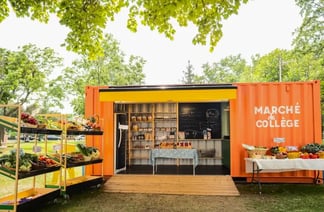How to Transform a Shipping Container into Commercial Space: A Comprehensive Guide

You’ve heard about shipping containers being converted into shops, cafés, or coworking spaces, but how do you turn that idea into reality? Transforming a shipping container might seem like a monumental task, especially if you’re just starting out. However, with careful planning, it’s an innovative and cost-effective way to stand out. In this article, we’ll guide you step-by-step to turn your container into a unique and functional commercial space.
1. Understand Your Needs and Define the Concept
Before diving in, it's crucial to clarify your expectations.
- Type of Business: Is it a shop, a café, or a coworking space? Each use affects the required layout.
- Target Audience: Who are your customers, and what are they looking for? A well-designed container should provide a welcoming and memorable experience.
- Visual Concept: Choose a distinctive style (industrial, minimalist, or eco-friendly) that grabs attention and enhances your brand image.
Pro Tip: Sketch a blueprint or use software to visualize your project.
2. Choose the Right Container
Selecting the perfect container is a critical step.
- Dimensions: Standard sizes (6 meters or 12 meters) depend on your available space and needs.
- Condition: Invest in a container in good shape to minimize unexpected repairs.
- Specific Features: Need insulation or refrigeration? Consider refrigerated or insulated containers.
Important: Always request an inspection report before purchasing.
3. Plan the Transformation
Turning a bare container into a functional space involves key steps:
- Thermal and Acoustic Insulation: Metal containers amplify temperature changes, so invest in quality insulation materials.
- Cutouts: Add windows, doors, and terraces for natural light and accessibility.
- Electrical and Plumbing Systems: Plan for lighting, ventilation, and water connections if needed.
Practical Example: A container café with large glass panels and an integrated terrace for a cozy atmosphere.
4. Ensure Compliance With Regulations
Compliance is paramount:
- Building Permits: Check local requirements to avoid legal setbacks.
- Safety Standards: Include fire safety measures and accessibility features for people with reduced mobility (PRM).
- Environmental Standards: Opt for sustainable materials and plan for waste recycling.
Takeaway: A compliant project boosts your credibility with customers and authorities.
5. Design the Interior and Exterior
Create a functional and inviting space:
- Interior Design: Choose modular furniture and built-in storage to maximize space.
- Décor: Align colors and style with your brand identity.
- Exterior Design: Add visible signage and auxiliary spaces like a terrace or garden.
Inspiration: A minimalist coworking space or a colorful, eye-catching pop-up shop.
6. Promote Your Commercial Space
To attract your first customers, invest in an effective marketing strategy:
- Visual Marketing: Make the container’s design a standout feature.
- Social Media: Share your project’s progress with engaging photos and videos.
- Events: Host an opening or workshops to boost visibility.
Try This: Launch an Instagram campaign showcasing the "before and after" transformation.
Conclusion: A Bold and Sustainable Project
Transforming a shipping container into a commercial space is both bold and achievable. By following the steps outlined here, you can create a functional, aesthetic, and eco-friendly space. Now, it’s time to take the plunge. Your next customer might already be on their way!
Discover more inspiring container transformation examples to spark your creativity.
